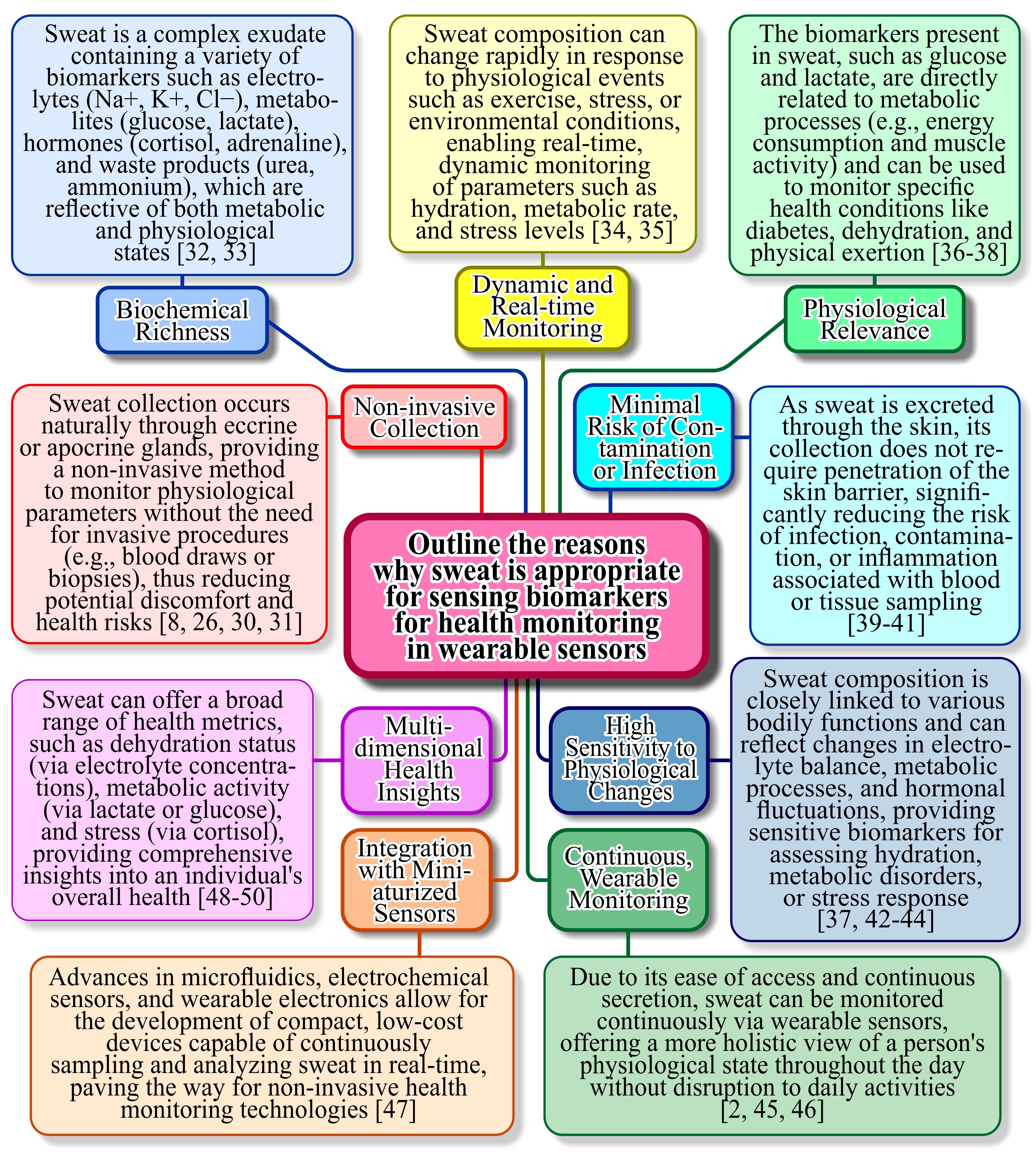Trends and Advances in Wearable Plasmonic Sensors Utilizing Surface-Enhanced Raman Spectroscopy (SERS): A Comprehensive Review
Abstract
1. Introduction
2. Fundamentals of Plasmonics
2.1. Plasmonic Principles
2.2. Materials for Plasmonics
2.3. Key Design Considerations
3. Fabrication and Integration Techniques
3.1. Nanostructure Fabrication
3.1.1. Top-Down Approaches (e.g., Lithography)
3.1.2. Bottom-Up Approaches (e.g., Self-Assembly)
3.2. Flexible Substrate Integration
3.2.1. Materials for Flexibility (e.g., Polymers, Textiles)
3.2.2. Methods of Attaching Plasmonic Nanostructures to Wearable Substrates
3.3. Powering and Readout Mechanisms
3.3.1. Miniaturization of Electronic Components
3.3.2. Advances in Wireless Communication for Data Transmission
4. Recent Advances in Wearable Plasmonic Sweat Sensors Based on SERS Technique
5. Advancing Wearable Sensors Through AI
6. Concluding Remarks and Outlook
Author Contributions
Funding
Institutional Review Board Statement
Informed Consent Statement
Data Availability Statement
Acknowledgments
Conflicts of Interest
References
- Alugubelli, N.; Abuissa, H.; Roka, A. Wearable devices for remote monitoring of heart rate and heart rate variability—What We know and what is coming. Sensors 2022, 22, 8903. [Google Scholar] [CrossRef] [PubMed]
- Kazanskiy, N.L.; Khonina, S.N.; Butt, M.A. A review on flexible wearables—Recent developments in non-invasive continuous health monitoring. Sens. Actuators A Phys. 2024, 366, 114993. [Google Scholar] [CrossRef]
- Lv, Z.; Li, Y. Wearable sensors for vital signs measurement: A survey. J. Sens. Actuator Netw. 2022, 11, 19. [Google Scholar] [CrossRef]
- Butt, M.A.; Kazanskiy, N.L.; Khonina, S.N. Revolution in flexible wearable electronics for temperature and pressure monitoring—A review. Electronics 2022, 11, 716. [Google Scholar] [CrossRef]
- Yilmaz, T.; Foster, R.; Hao, Y. Detecting vital signs with wearable wireless sensors. Sensors 2010, 10, 10837–10862. [Google Scholar] [CrossRef] [PubMed]
- Cui, X.; Huang, F.; Zhang, X.; Song, P.; Zheng, H.; Chevali, V.; Wang, H.; Xu, Z. Flexible pressure sensors via engineering microstructures for wearable human-machine interaction and health monitoring applications. iScience 2022, 25, 104148. [Google Scholar] [CrossRef]
- Bandodkar, A.J.; Jia, W.; Wang, J. Tattoo-based wearable electrochemical devices: A review. Electroanalysis 2015, 27, 562–572. [Google Scholar] [CrossRef]
- Donelli, M.; Espa, G.; Feraco, P.; Manekiya, M. Wearable non-invasive blood glucose monitor system based on galvanic skin resistance measurement. Electron. Lett. 2021, 57, 901–902. [Google Scholar] [CrossRef]
- Kim, J.; de Araujo, W.R.; Samek, I.A.; Bandodkar, A.J.; Jia, W.; Brunetti, B.; Paixão, T.R.L.C.; Wang, J. Wearable temporary tattoo sensor for real-time trace metal monitoring in human sweat. Electrochem. Commun. 2015, 51, 41–45. [Google Scholar] [CrossRef]
- Dave, D.; Vyas, K.; Branan, K.; McKay, S.; DeSalvo, D.J.; Gutierrez-Osuna, R.; Cote, G.L.; Erraguntla, M. Detection of hypoglycemia and hyperglycemia using noninvasive wearable sensors: Electrocardiograms and accelerometry. J. Diabetes Sci. Technol. 2024, 18, 351–362. [Google Scholar] [CrossRef] [PubMed]
- Abdulamier, A.A.; Shaker, L.M.; Al-Amiery, A.A.; Qasim, M.T.; Isahak, W.N.R.W.; Luthfi, A.A.I. Advancements and applications of smart contact lenses: A comprehensive review. Results Eng. 2024, 24, 103268. [Google Scholar] [CrossRef]
- Park, J.; Kim, J.; Kim, S.-Y.; Cheong, W.H.; Jang, J.; Park, Y.G.; Na, K.; Kim, Y.T.; Heo, J.H.; Lee, C.Y.; et al. Soft, smart contact lenses with integrations of wireless circuits, glucose sensors, and displays. Sci. Adv. 2018, 4, eaap9841. [Google Scholar] [CrossRef] [PubMed]
- Kazanskiy, N.L.; Khonina, S.N.; Butt, M.A. Smart contact lenses—A step towards non-invasive continuous eye health monitoring. Biosensors 2023, 13, 933. [Google Scholar] [CrossRef] [PubMed]
- Kim, T.; Kalhori, A.H.; Kim, T.-H.; Bao, C.; Kim, W.S. 3D designed battery-free wireless origami pressure sensor. Microsyst. Nanoeng. 2022, 8, 120. [Google Scholar] [CrossRef]
- Yun, J.; Li, Z.; Miao, X.; Li, X.; Lee, J.Y.; Zhao, W.; Lee, S.W. A tear-based battery charged by biofuel for smart contact lenses. Nano Energy 2023, 110, 108344. [Google Scholar] [CrossRef]
- Wang, Y.; Zhao, C.; Wang, J.; Luo, X.; Xie, L.; Zhan, S.; Kim, J.; Wang, X.; Liu, X.; Ying, Y. Wearable plasmonic-metasurface sensor for noninvasive and universal molecular fingerprint detection on biointerfaces. Sci. Adv. 2021, 7, eabe4553. [Google Scholar] [CrossRef] [PubMed]
- Butt, M.A. Insight into plasmonics: Resurrection of modern-day science (invited). Comput. Opt. 2024, 48, 5–17. [Google Scholar] [CrossRef]
- Kazanskiy, N.L.; Butt, M.A.; Degtyarev, S.A.; Khonina, S.N. Achievements in the development of plasmonic waveguide sensors for measuring the refractive index. Comput. Opt. 2020, 44, 295–318. [Google Scholar] [CrossRef]
- Sepúlveda, B.; Angelomé, P.C.; Lechuga, L.M.; Liz-Marzán, L.M. LSPR-based nanobiosensors. Nano Today 2009, 4, 244–251. [Google Scholar] [CrossRef]
- Atta, S.; Zhao, Y.; Sanchez, S.; Vo-Dinh, T. A simple and sensitive wearable SERS sensor utilizing plasmonic-active gold nanostars. ACS Omega 2024, 9, 38897–38905. [Google Scholar] [CrossRef] [PubMed]
- Xu, J.; Fang, Y.S.; Chen, J. Wearable biosensors for non-invasive sweat diagnostics. Biosensors 2021, 11, 245. [Google Scholar] [CrossRef] [PubMed]
- Childs, A.; Mayol, B.; Lasalde-Ramírez, J.A.; Song, Y.; Sempionatto, J.R.; Gao, W. Diving into sweat: Advances, challenges, and future directions in wearable sweat sensing. ACS Nano 2024, 18, 24605–24616. [Google Scholar] [CrossRef]
- Xiao, J.; Wang, J.; Luo, Y.; Xu, T.; Zhang, X. Wearable plasmonic sweat biosensor for acetaminophen drug monitoring. ACS Sens. 2023, 8, 1766–1773. [Google Scholar] [CrossRef] [PubMed]
- Tabasum, H.; Gill, N.; Mishra, R.; Lone, S. Wearable microfluidic-based e-skin sweat sensors. RSC Adv. 2022, 12, 8691–8707. [Google Scholar] [CrossRef]
- Min, J.; Tu, J.; Xu, C.; Lukas, H.; Shin, S.; Yang, Y.; Solomon, S.A.; Mukasa, D.; Gao, W. Skin-interfaced wearable sweat sensors for precision medicine. Chem. Rev. 2023, 123, 5049–5138. [Google Scholar] [CrossRef]
- Xing, Z.; Hui, J.; Lin, B.; Wu, Z.; Mao, H. Recent advances in wearable sensors for the monitoring of sweat: A comprehensive tendency summary. Chemosensors 2023, 11, 470. [Google Scholar] [CrossRef]
- Jo, S.; Sung, D.; Kim, S.; Koo, J. A review of wearable biosensors for sweat analysis. Biomed. Eng. Lett. 2021, 11, 117–129. [Google Scholar] [CrossRef] [PubMed]
- D’Andrea, C.; Banchelli, M.; Amicucci, C.; Polykretis, P.; Micheletti, F.; de Angelis, M.; Han, Y.; Ha, H.; Hwang, B.; Matteini, P. Development of a wearable sweat sensor chip based on surface-enhanced Raman spectroscopy. Proceedings 2024, 97, 9. [Google Scholar] [CrossRef]
- Mogera, U.; Guo, H.; Namkoong, M.; Rahman, M.S.; Nguyen, T.; Tian, L. Wearable plasmonic paper–based microfluidics for continuous sweat analysis. Sci. Adv. 2022, 8, eabn1736. [Google Scholar] [CrossRef] [PubMed]
- Xuan, X.; Chen, C.; Molinero-Fernandez, A.; Ekelund, E.; Cardinale, D.; Swarén, M.; Wedholm, L.; Cuartero, M.; Crespo, G.A. Fully integrated wearable device for continuous sweat lactate monitoring in sports. ACS Sens. 2023, 8, 2401–2409. [Google Scholar] [CrossRef]
- Hanna, J.; Tawk, Y.; Azar, S.; Ramadan, A.H.; Dia, B.; Shamieh, E.; Zoghbi, S.; Kanj, R.; Costantine, J.; Eid, A.A. Wearable flexible body matched electromagnetic sensors for personalized non-invasive glucose monitoring. Sci. Rep. 2022, 12, 14885. [Google Scholar] [CrossRef]
- Serag, A.; Shakkour, Z.; Halboup, A.M.; Kobeissy, F.; Farag, M.A. Sweat metabolome and proteome: Recent trends in analytical advances and potential biological functions. J. Proteom. 2021, 246, 104310. [Google Scholar] [CrossRef]
- Brasier, N.; Eckstein, J. Sweat as a source of next-generation digital biomarkers. Digit. Biomark. 2019, 3, 155–165. [Google Scholar] [CrossRef] [PubMed]
- Binabaji, F.; Dashtian, K.; Zare-Dorabei, R.; Naseri, N.; Noroozifar, M.; Kerman, K. Innovative wearable sweat sensor array for real-time volatile organic compound detection in noninvasive diabetes monitoring. Anal. Chem. 2024, 96, 13522–13532. [Google Scholar] [CrossRef] [PubMed]
- Gao, F.; Liu, C.; Zhang, L.; Liu, T.; Wang, Z.; Song, Z.; Cai, H.; Fang, Z.; Chen, J.; Wang, J.; et al. Wearable and flexible electrochemical sensors for sweat analysis: A review. Microsyst. Nanoeng. 2023, 9, 1. [Google Scholar] [CrossRef] [PubMed]
- Seshadri, D.R.; Li, R.T.; Voos, J.E.; Rowbottom, J.R.; Alfes, C.M.; Zorman, C.A.; Drummond, C.K. Wearable sensors for monitoring the physiological and biochemical profile of the athlete. npj Digit. Med. 2019, 2, 72. [Google Scholar] [CrossRef] [PubMed]
- Srikrishnarka, P.; Haapasalo, J.; Hinestroza, J.P.; Sun, Z. Nonappa wearable sensors for physiological condition and activity monitoring. Small Sci. 2024, 4, 2300358. [Google Scholar] [CrossRef]
- Latino, F.; Tafuri, F. Wearable sensors and the evaluation of physiological performance in elite field hockey players. Sports 2024, 12, 124. [Google Scholar] [CrossRef] [PubMed]
- Meng, H.; Zhong, W.; Ma, K.; Su, J.; Ma, L.; Hao, Y.; Jiang, Y.; Liu, X.; Fu, X.; Zhang, C. Flexible wearable sensors: An emerging platform for monitoring of bacterial infection in skin wounds. Eng. Regen. 2024, 5, 186–198. [Google Scholar] [CrossRef]
- Pusta, A.; Tertiș, M.; Cristea, C.; Mirel, S. Wearable sensors for the detection of biomarkers for wound infection. Biosensors 2022, 12, 1. [Google Scholar] [CrossRef]
- Xue, Z.; Gai, Y.; Wu, Y.; Liu, Z.; Li, Z. Wearable mechanical and electrochemical sensors for real-time health monitoring. Commun. Mater. 2024, 5, 211. [Google Scholar] [CrossRef]
- Qin, W.; Xue, Y.; Li, G.; Peng, H.; Gong, G.; Yan, R.; Zhao, X.; Pang, J. Highly-sensitive wearable pressure sensor based on AgNWs/MXene/Non-woven fabric. Org. Electron. 2024, 125, 106958. [Google Scholar] [CrossRef]
- Liu, Y.; Qi, D. High sensitive ultrathin wearable sensor for physiological signal monitoring. In Proceedings of the 2020 IEEE International Conference on E-health Networking, Application & Services (HEALTHCOM), Shenzhen, China, 1–2 March 2021; pp. 1–2. [Google Scholar]
- Li, Z.; Tang, X.; Zhao, T.; Chen, K.; Zhang, T. Highly sensitive skin-like wearable optical sensor for human physiological signals monitoring. Opt. Fiber Technol. 2024, 82, 103652. [Google Scholar] [CrossRef]
- Baghelani, M.; Abbasi, Z.; Daneshmand, M.; Light, P.E. Non-invasive continuous-time glucose monitoring system using a chipless printable sensor based on split ring microwave resonators. Sci. Rep. 2020, 10, 12980. [Google Scholar] [CrossRef] [PubMed]
- Kulkarni, M.B.; Rajagopal, S.; Prieto-Simón, B.; Pogue, B.W. Recent advances in smart wearable sensors for continuous human health monitoring. Talanta 2024, 272, 125817. [Google Scholar] [CrossRef] [PubMed]
- Wu, J.; Lin, X.; Yang, C.; Yang, S.; Liu, C.; Cao, Y. Wearable sensors based on miniaturized high-performance hybrid nanogenerator for medical health monitoring. Biosensors 2024, 14, 361. [Google Scholar] [CrossRef] [PubMed]
- Zhang, Z.; Wang, H.; Gong, S.; Li, S. A multi-dimensional information sensing and monitoring system based on wearable devices. In Proceedings of the 2023 International Conference on AI and Metaverse in Supply Chain Management, Bhubaneswar, India, 18–19 November 2024; pp. 1–8. [Google Scholar] [CrossRef]
- Malode, S.J.; Alshehri, M.A.; Shetti, N.P. Revolutionizing human healthcare with wearable sensors for monitoring human strain. Colloids Surf. B Biointerfaces 2025, 246, 114384. [Google Scholar] [CrossRef] [PubMed]
- Huang, W.; Song, A.; Wan, B.; Guo, J. Wearable health monitoring system based on layered 3D-Mobilenet. Procedia Comput. Sci. 2022, 202, 373–378. [Google Scholar] [CrossRef]
- Koh, E.H.; Lee, W.-C.; Choi, Y.-J.; Moon, J.-I.; Jang, J.; Park, S.-G.; Choo, J.; Kim, D.-H.; Jung, H.S. A wearable surface-enhanced Raman scattering sensor for label-free molecular detection. ACS Appl. Mater. Interfaces 2021, 13, 3024–3032. [Google Scholar] [CrossRef]
- Abuhelwa, M.; Singh, A.; Liu, J.; Almalaysha, M.; Carlson, A.V.; Trout, K.E.; Morey, A.; Kinzel, E.; Channaiah, L.H.; Almasri, M. Fiber optics-based surface enhanced Raman spectroscopy sensors for rapid multiplex detection of foodborne pathogens in raw poultry. Microsyst. Nanoeng. 2024, 10, 199. [Google Scholar] [CrossRef] [PubMed]
- Chauhan, N.; Saxena, K.; Rawal, R.; Yadav, L.; Jain, U. Advances in surface-enhanced Raman spectroscopy-based sensors for detection of various biomarkers. Prog. Biophys. Mol. Biol. 2023, 184, 32–41. [Google Scholar] [CrossRef] [PubMed]
- Yang, Y.; Wu, S.; Chen, Y.; Ju, H. Surface-enhanced Raman scattering sensing for detection and mapping of key cellular biomarkers. Chem. Sci. 2023, 14, 12869–12882. [Google Scholar] [CrossRef]
- Zangana, S.; Veres, M.; Bonyár, A. Surface-enhanced Raman spectroscopy (SERS)-based sensors for deoxyribonucleic acid (DNA) detection. Molecules 2024, 29, 3338. [Google Scholar] [CrossRef] [PubMed]
- Shvalya, V.; Filipič, G.; Zavašnik, J.; Abdulhalim, I.; Cvelbar, U. Surface-enhanced Raman spectroscopy for chemical and biological sensing using nanoplasmonics: The relevance of interparticle spacing and surface morphology. Appl. Phys. Rev. 2020, 7, 031307. [Google Scholar] [CrossRef]
- Barchiesi, D.; Gharbi, T.; Cakir, D.; Anglaret, E.; Fréty, N.; Kessentini, S.; Maâlej, R. Performance of surface plasmon resonance sensors using copper/copper oxide films: Influence of thicknesses and optical properties. Photonics 2022, 9, 104. [Google Scholar] [CrossRef]
- Chain, C.Y.; Daza Millone, M.A.; Cisneros, J.S.; Ramirez, E.A.; Vela, M.E. Surface plasmon resonance as a characterization tool for lipid nanoparticles used in drug delivery. Front. Chem. 2021, 8, 605307. [Google Scholar] [CrossRef] [PubMed]
- Butt, M.A. Features of the modern development of metal-insulator-metal waveguide based plasmonic sensors. Appl. Res. 2024, 3, e202400069. [Google Scholar] [CrossRef]
- Yu, H.; Peng, Y.; Yang, Y.; Li, Z.-Y. Plasmon-Enhanced Light–Matter Interactions and Applications. npj Comput. Mater. 2019, 5, 45. [Google Scholar] [CrossRef]
- Losurdo, M.; Moreno, F.; Cobet, C.; Modreanu, M.; Pernice, W. Plasmonics: Enabling functionalities with novel materials. J. Appl. Phys. 2021, 129, 220401. [Google Scholar] [CrossRef]
- Guo, Y.; Xu, Z.; Curto, A.G.; Zeng, Y.-J.; Van Thourhout, D. Plasmonic Semiconductors: Materials, tunability and applications. Prog. Mater. Sci. 2023, 138, 101158. [Google Scholar] [CrossRef]
- Zhang, D.; Pu, H.; Huang, L.; Sun, D.-W. Advances in flexible surface-enhanced Raman scattering (SERS) substrates for nondestructive food detection: Fundamentals and recent applications. Trends Food Sci. Technol. 2021, 109, 690–701. [Google Scholar] [CrossRef]
- Li, Z.; Huang, X.; Lu, G. Recent developments of flexible and transparent SERS substrates. J. Mater. Chem. C 2020, 8, 3956–3969. [Google Scholar] [CrossRef]
- Kim, S.; Yoon, S. On the origin of the plasmonic properties of gold nanoparticles. Bull. Korean Chem. Soc. 2021, 42, 1058–1065. [Google Scholar] [CrossRef]
- Otto, A. Excitation of nonradiative surface plasma waves in silver by the method of frustrated total reflection. Z. Physik 1968, 216, 398–410. [Google Scholar] [CrossRef]
- Cortie, M.B.; Arnold, M.D.; Keast, V.J. The quest for zero loss: Unconventional materials for plasmonics. Adv. Mater. 2020, 32, e1904532. [Google Scholar] [CrossRef] [PubMed]
- Shukla, S.; Arora, P. Aluminum as a competitive plasmonic material for the entire electromagnetic spectrum: A review. Results Opt. 2025, 18, 100760. [Google Scholar] [CrossRef]
- Ni, G.X.; McLeod, A.S.; Sun, Z.; Wang, L.; Xiong, L.; Post, K.W.; Sunku, S.S.; Jiang, B.Y.; Hone, J.; Dean, C.R.; et al. Fundamental limits to graphene plasmonics. Nature 2018, 557, 530–533. [Google Scholar] [CrossRef] [PubMed]
- Zhang, Z.; Lee, Y.; Haque, M.F.; Leem, J.; Hsieh, E.Y.; Nam, S. Plasmonic sensors based on graphene and graphene hybrid materials. Nano Converg. 2022, 9, 28. [Google Scholar] [CrossRef] [PubMed]
- Xu, Y.; Li, X.; Jiang, L.; Meng, G.; Ran, P.; Lu, Y. Fast and eco-friendly fabrication of uniform Ag substrates for highly sensitive surface-enhanced Raman scattering. Appl. Phys. A 2017, 123, 322. [Google Scholar] [CrossRef]
- Farling, C.G.; Stackaruk, M.C.; Pye, C.C.; Brosseau, C.L. Fabrication of high quality electrochemical SERS (EC-SERS) substrates using physical vapour deposition. Phys. Chem. Chem. Phys. 2021, 23, 20065–20072. [Google Scholar] [CrossRef]
- Cao, Z.; Kang, X.; Lü, W.; Wang, H. Eco-friendly fabrication and luminescent properties of flexible Ag–In–Zn–S/ZnS QD-WPU composite film. Polymer 2025, 317, 127975. [Google Scholar] [CrossRef]
- Kuchmizhak, A.; Pustovalov, E.; Syubaev, S.; Vitrik, O.; Kulchin, Y.; Porfirev, A.; Khonina, S.; Kudryashov, S.; Danilov, P.; Ionin, A. On-fly femtosecond-laser fabrication of self-organized plasmonic nanotextures for chemo- and biosensing applications. ACS Appl. Mater. Interfaces 2016, 8, 24946–24955. [Google Scholar] [CrossRef]
- Pavlov, D.; Porfirev, A.; Khonina, S.; Pan, L.; Kudryashov, S.I.; Kuchmizhak, A.A. Coaxial hole array fabricated by ultrafast femtosecond-laser processing with spatially multiplexed vortex beams for surface Enhanced infrared absorption. Appl. Surf. Sci. 2021, 541, 148602. [Google Scholar] [CrossRef]
- Busleev, N.I.; Kudryashov, S.I.; Danilov, P.A.; Porfir’ev, A.P.; Saraeva, I.N.; Rudenko, A.A.; Umanskaya, S.F.; Zayarnyi, D.A.; Ionin, A.A.; Khonina, S.N. Symmetric nanostructuring and plasmonic excitation of gold nanostructures by femtosecond Laguerre–Gaussian laser beams. Quantum Electron. 2019, 49, 666. [Google Scholar] [CrossRef]
- Chowdhury, M.A.H.; Tasnim, N.; Hossain, M.; Habib, A. Flexible, stretchable, and single-molecule-sensitive SERS-active sensor for wearable biosensing applications. RSC Adv. 2023, 13, 20787–20798. [Google Scholar] [CrossRef] [PubMed]
- Borodaenko, Y.; Syubaev, S.; Gurbatov, S.; Zhizhchenko, A.; Porfirev, A.; Khonina, S.; Mitsai, E.; Gerasimenko, A.V.; Shevlyagin, A.; Modin, E.; et al. Deep subwavelength laser-induced periodic surface structures on silicon as a novel multifunctional biosensing platform. ACS Appl. Mater. Interfaces 2021, 13, 54551–54560. [Google Scholar] [CrossRef]
- Duan, C.; Zhang, Z.; Zhang, X.; An, M.; Zhang, Y.; Liu, Y.; Lu, M. High sensitivity and excellent durability of wearable microenvironmental humidity sensors inspired by the Spider-Web. Sens. Actuators B Chem. 2023, 377, 133056. [Google Scholar] [CrossRef]
- Babar, F.; Cheema, A.M.; Ahmad, Z.; Sarfraz, A.; Sarfraz, Z.; Ashraff, H.; Tayyab, H.; Bajwa, A.M.; Ali, H.; Sarfraz, M.; et al. Sensitivity and specificity of wearables for atrial fibrillation in elderly populations: A systematic review. Curr. Cardiol. Rep. 2023, 25, 761–779. [Google Scholar] [CrossRef] [PubMed]
- van Melzen, R.; Haveman, M.E.; Schuurmann, R.C.L.; van Amsterdam, K.; El Moumni, M.; Tabak, M.; Struys, M.M.R.F.; de Vries, J.-P.P.M. Validity and reliability of wearable sensors for continuous postoperative vital signs monitoring in patients recovering from trauma surgery. Sensors 2024, 24, 6379. [Google Scholar] [CrossRef] [PubMed]
- Liu, X.; Li, T.; Lee, T.-C.; Sun, Y.; Liu, Y.; Shang, L.; Han, Y.; Deng, W.; Yuan, Z.; Dang, A. Wearable plasmonic sensors engineered via active-site maximization of TiVC MXene for universal physiological monitoring at the molecular level. ACS Sens. 2024, 9, 483–493. [Google Scholar] [CrossRef]
- Nan, M.; Darmawan, B.A.; Go, G.; Zheng, S.; Lee, J.; Kim, S.; Lee, T.; Choi, E.; Park, J.-O.; Bang, D. Wearable localized surface plasmon resonance-based biosensor with highly sensitive and direct detection of cortisol in human sweat. Biosensors 2023, 13, 184. [Google Scholar] [CrossRef] [PubMed]
- Lalouani, W.; Younis, M.; White-Gittens, I.; Emokpae, R.N.; Emokpae, L.E. Energy-efficient collection of wearable sensor data through predictive sampling. Smart Health 2021, 21, 100208. [Google Scholar] [CrossRef]
- Magno, M.; Benini, L.; Spagnol, C.; Popovici, E. Wearable low power dry surface wireless sensor node for healthcare monitoring application. In Proceedings of the 2013 IEEE 9th International Conference on Wireless and Mobile Computing, Networking and Communicatisons (WiMob), Lyon, France, 7–9 October 2013; pp. 189–195. [Google Scholar]
- Bakri, M.H.; Özarslan, A.C.; Erarslan, A.; Elalmis, Y.B.; Ciftci, F. Biomedical applications of wearable biosensors. Next Mater. 2024, 3, 100084. [Google Scholar] [CrossRef]
- Ramirez-Priego, P.; Mauriz, E.; Giarola, J.F.; Lechuga, L.M. Overcoming challenges in plasmonic biosensors deployment for clinical and biomedical applications: A systematic review and meta-analysis. Sens. Bio-Sens. Res. 2024, 46, 100717. [Google Scholar] [CrossRef]
- Bandodkar, A.J.; Jeerapan, I.; Wang, J. Wearable chemical sensors: Present challenges and future prospects. ACS Sens. 2016, 1, 464–482. [Google Scholar] [CrossRef]
- Liu, H.; Wang, L.; Linc, G.; Feng, Y. Recent progress in the fabrication of flexible materials for wearable sensors. Biomater. Sci. 2022, 10, 614–632. [Google Scholar] [CrossRef] [PubMed]
- Liu, F.; Lorenzelli, L. Toward all flexible sensing systems for next-generation wearables. Wearable Electron. 2024, 1, 137–149. [Google Scholar] [CrossRef]
- Kang, H.; Cho, A.; Park, S.; Cho, S.-Y.; Jung, H.-T. Top-Down Fabrication of Chemical and Biological Sensors. Acc. Mater. Res. 2024, 5, 1484–1495. [Google Scholar] [CrossRef]
- Liaros, N.; Fourkas, J.T. Ten years of two-color photolithography [Invited]. Opt. Mater. Express 2019, 9, 3006. [Google Scholar] [CrossRef]
- Chen, Y. Nanofabrication by electron beam lithography and its applications: A review. Microelectron. Eng. 2015, 135, 57–72. [Google Scholar] [CrossRef]
- Fialkova, S.; Yarmolenko, S.; Krishnaswamy, A.; Sankar, J.; Shanov, V.; Schulz, M.J.; Desai, S. Nanoimprint lithography for next-generation carbon nanotube-based devices. Nanomaterials 2024, 14, 1011. [Google Scholar] [CrossRef] [PubMed]
- Ober, C.K.; Käfer, F.; Yuan, C. Recent developments in photoresists for extreme-ultraviolet lithography. Polymer 2023, 280, 126020. [Google Scholar] [CrossRef]
- Shao, J.; Chen, X.; Li, X.; Tian, H.; Wang, C.; Lu, B. Nanoimprint lithography for the manufacturing of flexible electronics. Sci. China Technol. Sci. 2019, 62, 175–198. [Google Scholar] [CrossRef]
- Colniță, A.; Marconi, D.; Dina, N.E.; Brezeștean, I.; Bogdan, D.; Turcu, I. 3D silver metallized nanotrenches fabricated by nanoimprint lithography as flexible sers detection platform. Spectrochim. Acta A Mol. Biomol. Spectrosc. 2022, 276, 121232. [Google Scholar] [CrossRef] [PubMed]
- Zeng, P.; Zhou, Y.; Chen, H.; Fu, Y.; Pan, M.; Chen, G.; Yang, X.; Liu, Q.; Zheng, M. Silver-coated PMMA nanoparticles-on-a-mirror substrates as high-performance SERS sensors for detecting infinitesimal molecules. Sci. Rep. 2024, 14, 31627. [Google Scholar] [CrossRef]
- Borah, R.; Raj AG, K.; Minja, A.C.; Verbruggen, S.W. A review on self-assembly of colloidal nanoparticles into clusters, patterns, and films: Emerging synthesis techniques and applications. Small Methods 2023, 7, 2201536. [Google Scholar] [CrossRef] [PubMed]
- Qiu, J.; Chu, Y.; He, Q.; Han, Y.; Zhang, Y.; Han, L. A self-assembly hydrophobic oCDs/Ag nanoparticles SERS sensor for ultrasensitive melamine detection in milk. Food Chem. 2023, 402, 134241. [Google Scholar] [CrossRef] [PubMed]
- Zhou, H.; Qiu, J.; Zhang, Y.; Liang, Y.; Han, L.; Zhang, Y. Self-assembled C-Ag hybrid nanoparticle on nanoporous GaN enabled ultra-high enhancement factor SERS sensor for sensitive thiram detection. J. Hazard. Mater. 2024, 469, 133868. [Google Scholar] [CrossRef] [PubMed]
- Zhao, Y.; Shi, L.; Tian, Y.; Zhang, L. Self-assembly at liquid-liquid interface: A new SERS substrate for analytical sensing†. Chin. J. Chem. 2023, 41, 569–580. [Google Scholar] [CrossRef]
- Lee, W.S.; Jeon, S.; Oh, S.J. Wearable sensors based on colloidal nanocrystals. Nano Converg. 2019, 6, 10. [Google Scholar] [CrossRef] [PubMed]
- Zhang, H.; Bu, X.; Yip, S.; Liang, X.; Ho, J.C. Self-assembly of colloidal particles for fabrication of structural color materials toward advanced intelligent systems. Adv. Intell. Syst. 2020, 2, 1900085. [Google Scholar] [CrossRef]
- Wang, S.; Tay, L.-L.; Liu, H. A SERS and Electrical Sensor from Gas-Phase Generated Ag nanoparticles self-assembled on planar substrates. Analyst 2016, 141, 1721–1733. [Google Scholar] [CrossRef] [PubMed]
- Mhlanga, N.; Domfe, T.; Skepu, A. Fabrication of surface enhanced Raman spectroscopy substrates on solid supports. Appl. Surf. Sci. 2019, 476, 1108–1117. [Google Scholar] [CrossRef]
- Chen, Y.; Si, K.J.; Sikdar, D.; Tang, Y.; Premaratne, M.; Cheng, W. Ultrathin plasmene nanosheets as soft and surface-attachable SERS substrates with high signal uniformity. Adv. Opt. Mater. 2015, 3, 919–924. [Google Scholar] [CrossRef]
- Dhawan, A.; Du, Y.; Batchelor, D.; Wang, H.N.; Leonard, D.; Misra, V.; Ozturk, M.; Gerhold, M.D.; Vo-Dinh, T. Hybrid top-down and bottom-up fabrication approach for wafer-scale plasmonic nanoplatforms. Nano-Micro Small 2011, 7, 727–731. [Google Scholar] [CrossRef] [PubMed]
- Deep UV Photolithography. Available online: https://www.newport.com/n/deep-uv-photolithography (accessed on 14 October 2023).
- Barcelo, S.; Li, Z. Nanoimprint lithography for nanodevice fabrication. Nano Converg. 2016, 3, 21. [Google Scholar] [CrossRef]
- Cialla-May, D.; Bonifacio, A.; Bocklitz, T.; Markin, A.; Markina, N.; Fornasaro, S.; Dwivedi, A.; Dib, T.; Farnesi, E.; Liu, C.; et al. Biomedical SERS—The current state and future trends. Chem. Soc. Rev. 2024, 53, 8957–8979. [Google Scholar] [CrossRef]
- Xu, K.; Zhou, R.; Takei, K.; Hong, M. Toward flexible surface-enhanced Raman scattering (SERS) sensors for point-of-care diagnostics. Adv. Sci. 2019, 6, 1900925. [Google Scholar] [CrossRef]
- Alsulami, Q.A.; Wageh, S.; Al-Ghamdi, A.A.; Bilal, R.M.H.; Saeed, M.A. A tunable and wearable dual-band metamaterial absorber based on polyethylene terephthalate (PET) substrate for sensing applications. Polymers 2022, 14, 4503. [Google Scholar] [CrossRef] [PubMed]
- Chung, M.; Skinner, W.H.; Robert, C.; Campbell, C.J.; Rossi, R.M.; Koutsos, V.; Radacsi, N. Fabrication of a wearable flexible sweat pH Sensor based on SERS-active Au/TPU electrospun nanofibers. ACS Appl. Mater. Interfaces 2021, 13, 51504–51518. [Google Scholar] [CrossRef]
- Sankauskaite, A.; Pauliukaite, R.; Baltusnikaite-Guzaitiene, J.; Abraitiene, A. Smart textile with integrated wearable electrochemical sensors. Curr. Opin. Electrochem. 2023, 42, 101410. [Google Scholar] [CrossRef]
- Li, S.; Li, H.; Lu, Y.; Zhou, M.; Jiang, S.; Du, X.; Guo, C. Advanced textile-based wearable biosensors for healthcare monitoring. Biosensors 2023, 13, 909. [Google Scholar] [CrossRef]
- Galli, V.; Sailapu, S.K.; Cuthbert, T.J.; Ahmadizadeh, C.; Hannigan, B.C.; Menon, C. Passive and wireless all-textile wearable sensor system. Adv. Sci. 2023, 10, 2206665. [Google Scholar] [CrossRef] [PubMed]
- Lu, W.; Wu, G.; Gan, L.; Zhang, Y.; Li, K. Functional fibers/textiles for smart sensing devices and applications in personal healthcare systems. Anal. Methods 2024, 16, 5372–5390. [Google Scholar] [CrossRef] [PubMed]
- Shah, M.A.; Pirzada, B.M.; Price, G.; Shibiru, A.L.; Qurashi, A. Applications of nanotechnology in smart textile industry: A critical review. J. Adv. Res. 2022, 38, 55–75. [Google Scholar] [CrossRef] [PubMed]
- Qin, H.; Hajiaghajani, A.; Escobar, A.R.; Zargari, A.H.A.; Jimenez, A.; Kurdahi, F.; Tseng, P. Laser-induced graphene-based smart textiles for wireless cross-body metrics. ACS Appl. Nano Mater. 2023, 6, 19158–19167. [Google Scholar] [CrossRef]
- Fateixa, S.; Pinheiro, P.C.; Nogueira, H.I.S.; Trindade, T. Gold loaded textile fibres as substrates for SERS detection. J. Mol. Struct. 2019, 1185, 333–340. [Google Scholar] [CrossRef]
- Liu, L.; Martinez Pancorbo, P.; Xiao, T.-H.; Noguchi, S.; Marumi, M.; Segawa, H.; Karhadkar, S.; Gala de Pablo, J.; Hiramatsu, K.; Kitahama, Y.; et al. Highly scalable, wearable surface-enhanced Raman spectroscopy. Adv. Opt. Mater. 2022, 10, 2200054. [Google Scholar] [CrossRef]
- Kesava Rao, V.; Tang, X.; Sekine, Y.; Egawa, M.; Dwivedi, P.K.; Kitahama, Y.; Yang, W.; Goda, K. An ultralow-cost, durable, flexible substrate for ultrabroadband surface-enhanced Raman spectroscopy. Adv. Photon. Res. 2024, 5, 2300291. [Google Scholar] [CrossRef]
- Sibug-Torres, S.M.; Grys, D.-B.; Kang, G.; Niihori, M.; Wyatt, E.; Spiesshofer, N.; Ruane, A.; de Nijs, B.; Baumberg, J.J. In situ electrochemical regeneration of nanogap hotspots for continuously reusable ultrathin SERS sensors. Nat. Commun. 2024, 15, 2022. [Google Scholar] [CrossRef]
- Zou, X.; Silva, R.; Huang, X.; Al-Sharab, J.F.; Asefa, T. A self-cleaning porous TiO2–Ag core–shell nanocomposite material for surface-enhanced Raman scattering. Chem. Commun. 2012, 49, 382–384. [Google Scholar] [CrossRef] [PubMed]
- Sun, N.; Huang, B.; Lv, Z.; Ran, N.; Gan, Y.; Zhang, J. UV-catalyzed TiO2–based optofluidic SERS chip for three online strategies: Fabrication, detection, and self-cleaning. Anal. Chem. 2024, 96, 9104–9112. [Google Scholar] [CrossRef]
- Mekonnen, M.L.; Workie, Y.A.; Su, W.-N.; Hwang, B.J. Plasmonic paper substrates for point-of-need applications: Recent developments and fabrication methods. Sens. Actuators B Chem. 2021, 345, 130401. [Google Scholar] [CrossRef]
- Herrera-Jimenez, E.J.; Bousser, E.; Schmitt, T.; Klemberg-Sapieha, J.E.; Martinu, L. Effect of plasma interface treatment on the microstructure, residual stress profile, and mechanical properties of PVD TiN coatings on Ti-6Al-4V substrates. Surf. Coat. Technol. 2021, 413, 127058. [Google Scholar] [CrossRef]
- Wang, C.; Zhang, C.; Liu, M.; Huang, Y.; Wang, H.; Ma, G.; Zhou, X.; Jin, G. The effect of laser textured resin surface on the adhesion of supersonic plasma sprayed Al2O3/PF composite coating. Surf. Coat. Technol. 2024, 487, 130990. [Google Scholar] [CrossRef]
- Yang, Y.; Wang, F.; Liu, Y.; Huang, H.; Tang, Z.; Wang, J.; Li, X.; Wu, M.; Wang, T.; Zheng, J.; et al. Effect of plasma treatment on nucleation of Au nanoparticles. J. Mater. Res. Technol. 2022, 20, 2235–2246. [Google Scholar] [CrossRef]
- Chen, C.; Zhang, M.; Zhu, J.; Tao, Z.; Qiu, L. Laser sintering of Cu nanoparticles deposited on ceramic substrates: Experiments and modeling. Addit. Manuf. 2023, 69, 103527. [Google Scholar] [CrossRef]
- Selvapriya, R.; Abhijith, T.; Ragavendran, V.; Sasirekha, V.; Reddy, V.S.; Mayandi, J. Screen printed multifunctional TiO2 photoanode with plasmonic Ag nanoparticles for performance enhancement of dye sensitized solar cell. Mater. Lett. 2020, 276, 128194. [Google Scholar] [CrossRef]
- Aïssa, B.; Ali, A. Piezo inkjet formation of Ag nanoparticles from microdots arrays for surface plasmonic resonance. Sci. Rep. 2024, 14, 4806. [Google Scholar] [CrossRef] [PubMed]
- Thuy, T.T.; Sharipov, M.; Lee, Y.; Huy, B.T.; Lee, Y.-I. Inkjet-based microreactor for the synthesis of silver nanoparticles on plasmonic paper decorated with chitosan nano-wrinkles for efficient on-site Surface-enhanced Raman Scattering (SERS). Nano Select 2020, 1, 499–509. [Google Scholar] [CrossRef]
- Mendoza-Dorantes, T.; Pal, U.; Vega-Acosta, J.R.; Márquez-Beltrán, C. Encapsulation and surface charge manipulation of organic and inorganic colloidal substrates by multilayered polyelectrolyte films. Colloids Surf. A Physicochem. Eng. Asp. 2013, 434, 253–259. [Google Scholar] [CrossRef]
- Wang, Q.; Han, W.; Wang, Y.; Lu, M.; Dong, L. Tape nanolithography: A rapid and simple method for fabricating flexible, wearable nanophotonic devices. Microsyst. Nanoeng. 2018, 4, 31. [Google Scholar] [CrossRef] [PubMed]
- He, R.; Liu, H.; Niu, Y.; Zhang, H.; Genin, G.M.; Xu, F. Flexible miniaturized sensor technologies for long-term physiological monitoring. npj Flex. Electron. 2022, 6, 20. [Google Scholar] [CrossRef]
- McDowell, M.T. The role of nanoscale science for advancing batteries. Nano Lett. 2021, 21, 6353–6355. [Google Scholar] [CrossRef] [PubMed]
- Hashemi, S.A.; Ramakrishna, S.; Aberle, A.G. Recent progress in flexible–wearable solar cells for self-powered electronic devices. Energy Environ. Sci. 2020, 13, 685–743. [Google Scholar] [CrossRef]
- Tian, X.; Wang, J.; Ji, J.; Lu, G. The performance investigation of the flexible photovoltaic cell under non-uniform distributed illumination. Renew. Energy 2025, 240, 122170. [Google Scholar] [CrossRef]
- Tang, X.; Jiang, H.; Wen, R.; Xue, D.; Zeng, W.; Han, Y.; Wu, L. Advancements and challenges on SERS-based multimodal biosensors for biotoxin detection. Trends Food Sci. Technol. 2024, 152, 104672. [Google Scholar] [CrossRef]
- Saeyee, T.; Plaipichit, S.; Wicharn, S. An Approach to the development of Raman spectroscopy system for field usage. J. Phys. Conf. Ser. 2023, 2431, 012020. [Google Scholar] [CrossRef]
- Rafailov, E.U.; Litvinova, K.S.; Sokolovski, S.G. New generation of compact laser sources for biomedical applications. In Proceedings of the 2016 18th International Conference on Transparent Optical Networks (ICTON), Trento, Italy, 10–14 July 2016; p. 1. [Google Scholar]
- Matsumura, G.; Honda, S.; Kikuchi, T.; Mizuno, Y.; Hara, H.; Kondo, Y.; Nakamura, H.; Watanabe, S.; Hayakawa, K.; Nakajima, K.; et al. Real-time personal healthcare data analysis using edge computing for multimodal wearable sensors. Device 2025, 3, 100597. [Google Scholar] [CrossRef]
- Buskermolen, A.D.; Lin, Y.T.; van Smeden, L.; van Haaften, R.B.; Yan, J.; Sergelen, K.; de Jong, A.M.; Prins, M.W. Continuous biomarker monitoring with single molecule resolution by measuring free particle motion. Nat. Commun. 2022, 13, 6052. [Google Scholar] [CrossRef]
- Min, J.; Demchyshyn, S.; Sempionatto, J.R.; Song, Y.; Hailegnaw, B.; Xu, C.; Yang, Y.; Solomon, S.; Putz, C.; Lehner, L.E.; et al. An autonomous wearable biosensor powered by a perovskite solar cell. Nat. Electron. 2023, 6, 630–641. [Google Scholar] [CrossRef] [PubMed]
- Longo, D.; Giudice, G.; D’Arrigo, G.; Sciuto, A. Portable Spectroscopy system for environmental monitoring: An SO2 case study. IEEE Sens. J. 2022, 22, 11135–11143. [Google Scholar] [CrossRef]
- Chen, Y.-H.; Liu, C.-Y.; Devereaux, Z.J.; Wang, C.-Y.; Trimpin, S.; Lu, I.-C. Applications of vacuum MAI on a portable mass spectrometer. Int. J. Mass. Spectrom. 2022, 474, 116798. [Google Scholar] [CrossRef]
- Fernandez-Alonso, F.J.; Hernández, Z.; Torres-Costa, V. A cost-effective portable multiband spectrophotometer for precision agriculture. Agriculture 2023, 13, 1467. [Google Scholar] [CrossRef]
- Folli, G.S.; Santos, L.P.; Santos, F.D.; Cunha, P.H.; Schaffel, I.F.; Borghi, F.T.; Barros, I.H.; Pires, A.A.; Ribeiro, A.V.; Romão, W.; et al. Food analysis by portable NIR spectrometer. Food Chem. Adv. 2022, 1, 100074. [Google Scholar] [CrossRef]
- Li, Y.; Guo, Y.; Chen, H.; Xiao, X.; Long, F.; Zhong, H.; Wang, K.; Guo, Z.; Zhuang, Z.; Liu, Z. Flexible wearable plasmonic paper-based microfluidics with expandable channel and adjustable flow rate for portable surface-enhanced raman scattering sweat sensing. ACS Photon. 2024, 11, 613–625. [Google Scholar] [CrossRef]
- Tripathy, S.; Chavva, S.; Coté, G.L.; Mabbott, S. Modular and handheld raman systems for SERS-based point-of-care diagnostics. Curr. Opin. Biomed. Eng. 2023, 28, 100488. [Google Scholar] [CrossRef]
- Critical evaluation of portable raman spectrometers: From rock outcrops and planetary analogs to cultural heritage—A review. Anal. Chim. Acta 2022, 1209, 339027. [CrossRef] [PubMed]
- Zhang, H.; Zhao, N.; Li, H.; Wang, M.; Hao, X.; Sun, M.; Li, X.; Yang, Z.; Yu, H.; Tian, C.; et al. 3D flexible SERS substrates integrated with a portable raman analyzer and wireless communication for point-of-care application. ACS Appl. Mater. Interfaces 2022, 14, 51253–51264. [Google Scholar] [CrossRef]
- Wearable Sized Raman Spectrometers, Wearable Raman Spectroscopic Devices/Engines, SERS (Surface Enhanced Raman Spectroscopy) and Raman Readers. Available online: https://www.bayspec.com/products/mini-wearable-analyzer/ (accessed on 29 December 2024).
- Zhang, T.; Lu, J.; Hu, F.; Hao, Q. Bluetooth low energy for wearable sensor-based healthcare systems. In Proceedings of the 2014 IEEE Healthcare Innovation Conference (HIC), Seattle, WA, USA, 8–10 October 2014; pp. 251–254. [Google Scholar] [CrossRef]
- Kang, M.H.; Lee, G.J.; Yun, J.H.; Song, Y.M. NFC-based wearable optoelectronics working with smartphone application for untact healthcare. Sensors 2021, 21, 878. [Google Scholar] [CrossRef] [PubMed]
- Sun, X.; Zhao, C.; Li, H. Wearable near-field communication sensors for healthcare: Materials, fabrication and application. Micromachines 2022, 13, 784. [Google Scholar] [CrossRef] [PubMed]
- Sequenex. Enhancing Wearable Medical Device Communication with BLE and NFC. Available online: https://sequenex.com/enhancing-wearable-medical-device-communication-with-ble-and-nfc/ (accessed on 29 December 2024).
- Bulić, P.; Kojek, G.; Biasizzo, A. Data transmission efficiency in bluetooth low energy versions. Sensors 2019, 19, 3746. [Google Scholar] [CrossRef]
- Halevi, T.; Ma, D.; Saxena, N.; Xiang, T. Secure proximity detection for NFC devices based on ambient sensor data. In Proceedings of the Computer Security—ESORICS 2012, Pisa, Italy, 10–12 September 2012; Foresti, S., Yung, M., Martinelli, F., Eds.; Springer: Berlin/Heidelberg, Germany, 2012; pp. 379–396. [Google Scholar]
- Eugenio, E.; Cortesi, A. WiFi-related energy consumption analysis of mobile devices in a walkable area by abstract interpretation. In Proceedings of the Distributed Computing and Internet Technology, Bhubaneswar, India, 13–16 January 2017; Krishnan, P., Radha Krishna, P., Parida, L., Eds.; Springer International Publishing: Cham, Switzerland, 2017; pp. 27–39. [Google Scholar]
- Kos, A.; Milutinović, V.; Umek, A. Challenges in wireless communication for connected sensors and wearable devices used in sport biofeedback applications. Future Gener. Comput. Syst. 2019, 92, 582–592. [Google Scholar] [CrossRef]
- Dian, F.J.; Vahidnia, R.; Rahmati, A. Wearables and the internet of things (IoT), applications, opportunities, and challenges: A survey. IEEE Access 2020, 8, 69200–69211. [Google Scholar] [CrossRef]
- Wen, S.; Guo, G. Static-dynamic hybrid communication scheduling and control co-design for networked control systems. ISA Trans. 2017, 71, 553–562. [Google Scholar] [CrossRef] [PubMed]
- Kong, L.; Li, W.; Zhang, T.; Ma, H.; Cao, Y.; Wang, K.; Zhou, Y.; Shamim, A.; Zheng, L.; Wang, X.; et al. Wireless technologies in flexible and wearable sensing: From materials design, system integration to applications. Adv. Mater. 2024, 36, 2400333. [Google Scholar] [CrossRef]
- Jian, S. Industrial design of wearable intelligent devices based on wireless networks. Meas. Sens. 2023, 30, 100934. [Google Scholar] [CrossRef]
- Roussel, T.J.; Jackson, D.J.; Baldwin, R.P.; Keynton, R.S. Amperometric techniques. In Encyclopedia of Microfluidics and Nanofluidics; Li, D., Ed.; Springer US: Boston, MA, USA, 2008; pp. 39–47. ISBN 978-0-387-48998-8. [Google Scholar]
- Guinovart, T.; Bandodkar, A.J.; Windmiller, J.R.; Andrade, F.J.; Wang, J. A potentiometric tattoo sensor for monitoring ammonium in sweat. Analyst 2013, 138, 7031–7038. [Google Scholar] [CrossRef] [PubMed]
- Scholz, F. Voltammetric techniques of analysis: The essentials. ChemTexts 2015, 1, 17. [Google Scholar] [CrossRef]
- Kwon, K.; Kim, J.U.; Deng, Y.; Krishnan, S.R.; Choi, J.; Jang, H.; Lee, K.; Su, C.J.; Yoo, I.; Wu, Y.; et al. An on-skin platform for wireless monitoring of flow rate, cumulative loss and temperature of sweat in real time. Nat. Electron. 2021, 4, 302–312. [Google Scholar] [CrossRef]
- Sekine, Y.; Kim, S.B.; Zhang, Y.; Bandodkar, A.J.; Xu, S.; Choi, J.; Irie, M.; Ray, T.R.; Kohli, P.; Kozai, N.; et al. A fluorometric skin-interfaced microfluidic device and smartphone imaging module for in situ quantitative analysis of sweat chemistry. Lab. Chip. 2018, 18, 2178–2186. [Google Scholar] [CrossRef]
- Zhang, S.; He, Z.; Zhao, W.; Liu, C.; Zhou, S.; Ibrahim, O.O.; Wang, C.; Wang, Q. Innovative material-based wearable non-invasive electrochemical sweat sensors towards biomedical applications. Nanomaterials 2024, 14, 857. [Google Scholar] [CrossRef] [PubMed]
- Wang, J.; Luo, Y.; Zhou, Z.; Xiao, J.; Xu, T.; Zhang, X. Epidermal wearable optical sensors for sweat monitoring. Commun. Mater. 2024, 5, 77. [Google Scholar] [CrossRef]
- He, X.; Fan, C.; Luo, Y.; Xu, T.; Zhang, X. Flexible microfluidic nanoplasmonic sensors for refreshable and portable recognition of sweat biochemical fingerprint. npj Flex. Electron. 2022, 6, 60. [Google Scholar] [CrossRef]
- Miyamoto, A.; Lee, S.; Cooray, N.F.; Lee, S.; Mori, M.; Matsuhisa, N.; Jin, H.; Yoda, L.; Yokota, T.; Itoh, A.; et al. Inflammation-free, gas-permeable, lightweight, stretchable on-skin electronics with nanomeshes. Nat. Nanotechnol. 2017, 12, 907–913. [Google Scholar] [CrossRef] [PubMed]
- Nahavandi, D.; Alizadehsani, R.; Khosravi, A.; Acharya, U.R. Application of artificial intelligence in wearable devices: Opportunities and challenges. Comput. Methods Programs Biomed. 2022, 213, 106541. [Google Scholar] [CrossRef]
- Junaid, S.B.; Imam, A.A.; Abdulkarim, M.; Surakat, Y.A.; Balogun, A.O.; Kumar, G.; Shuaibu, A.N.; Garba, A.; Sahalu, Y.; Mohammed, A.; et al. Recent advances in artificial intelligence and wearable sensors in healthcare delivery. Appl. Sci. 2022, 12, 10271. [Google Scholar] [CrossRef]
- Kadian, S.; Kumari, P.; Shukla, S.; Narayan, R. Recent advancements in machine learning enabled portable and wearable biosensors. Talanta Open 2023, 8, 100267. [Google Scholar] [CrossRef]
- Vu, C.C. Embedded-machine learning and soft, flexible sensors for wearable devices—Viewing from an AI engineer. Mater. Today Phys. 2024, 42, 101376. [Google Scholar] [CrossRef]
- Zhang, Y.; Hu, Y.; Jiang, N.; Yetisen, A.K. Wearable artificial intelligence biosensor networks. Biosens. Bioelectron. 2023, 219, 114825. [Google Scholar] [CrossRef] [PubMed]
- Shajari, S.; Kuruvinashetti, K.; Komeili, A.; Sundararaj, U. The emergence of ai-based wearable sensors for digital health technology: A review. Sensors 2023, 23, 9498. [Google Scholar] [CrossRef] [PubMed]
- Nashruddin, S.N.A.B.M.; Salleh, F.H.M.; Yunus, R.M.; Zaman, H.B. Artificial intelligence−powered electrochemical sensor: Recent advances, challenges, and prospects. Heliyon 2024, 10, e37964. [Google Scholar] [CrossRef]
- Li, J.Q.; Dukes, P.V.; Lee, W.; Sarkis, M.; Vo-Dinh, T. Machine learning using convolutional neural networks for SERS analysis of biomarkers in medical diagnostics. J. Raman Spectrosc. 2022, 53, 2044–2057. [Google Scholar] [CrossRef] [PubMed]
- Kim, M.G.; Jue, M.; Lee, K.H.; Lee, E.Y.; Roh, Y.; Lee, M.; Lee, H.J.; Lee, S.; Liu, H.; Koo, B.; et al. Deep learning assisted surface-enhanced Raman spectroscopy (SERS) for rapid and direct nucleic acid amplification and detection: Toward enhanced molecular diagnostics. ACS Nano 2023, 17, 18332–18345. [Google Scholar] [CrossRef] [PubMed]
- Safir, F.; Vu, N.; Tadesse, L.F.; Firouzi, K.; Banaei, N.; Jeffrey, S.S.; Saleh, A.A.E.; Khuri-Yakub, B.T.; Dionne, J.A. Combining acoustic bioprinting with AI-assisted Raman spectroscopy for high-throughput identification of bacteria in blood. Nano Lett. 2023, 23, 2065–2073. [Google Scholar] [CrossRef] [PubMed]
- Sun, J.; Gong, L.; Wang, W.; Gong, Z.; Wang, D.; Fan, M. Surface-Enhanced Raman Spectroscopy for on-Site Analysis: A Review of Recent Developments. Luminescence 2020, 35, 808–820. [Google Scholar] [CrossRef] [PubMed]
- Bi, X.; Lin, L.; Chen, Z.; Ye, J. Artificial Intelligence for Surface-Enhanced Raman Spectroscopy. Small Methods 2024, 8, 2301243. [Google Scholar] [CrossRef] [PubMed]
- Yigci, D.; Ahmadpour, A.; Tasoglu, S. AI-based metamaterial design for wearables. Adv. Sens. Res. 2024, 3, 2300109. [Google Scholar] [CrossRef]
- An, T.; Wen, J.; Dong, Z.; Zhang, Y.; Zhang, J.; Qin, F.; Wang, Y.; Zhao, X. Plasmonic biosensors with nanostructure for healthcare monitoring and diseases diagnosis. Sensors 2023, 23, 445. [Google Scholar] [CrossRef] [PubMed]
- Crystal, H.A.; Dickson, D.W.; Sliwinski, M.J.; Lipton, R.B.; Grober, E.; Marks-Nelson, H.; Antis, P. Pathological markers associated with normal aging and dementia in the elderly. Ann. Neurol. 1993, 34, 566–573. [Google Scholar] [CrossRef] [PubMed]
- Wu, J.; Liu, H.; Chen, W.; Ma, B.; Ju, H. Device Integration of Electrochemical Biosensors. Nat. Rev. Bioeng. 2023, 1, 346–360. [Google Scholar] [CrossRef] [PubMed]
- Bao, Q.; Li, G.; Cheng, W.; Yang, Z.; Qu, Z.; Wei, J.; Lin, L. Machine learning-assisted flexible wearable device for tyrosine detection. RSC Adv. 2023, 13, 23788–23795. [Google Scholar] [CrossRef] [PubMed]

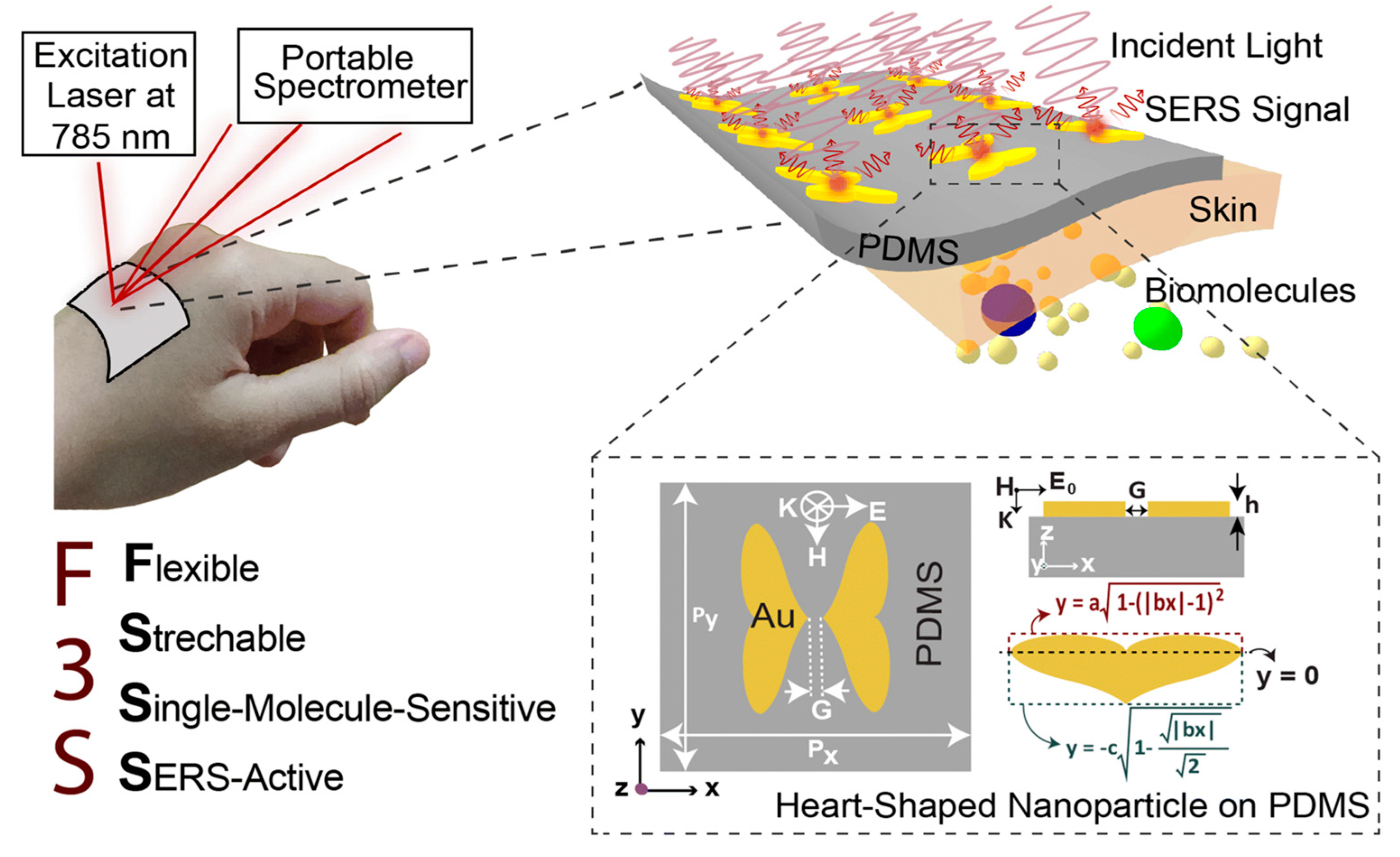


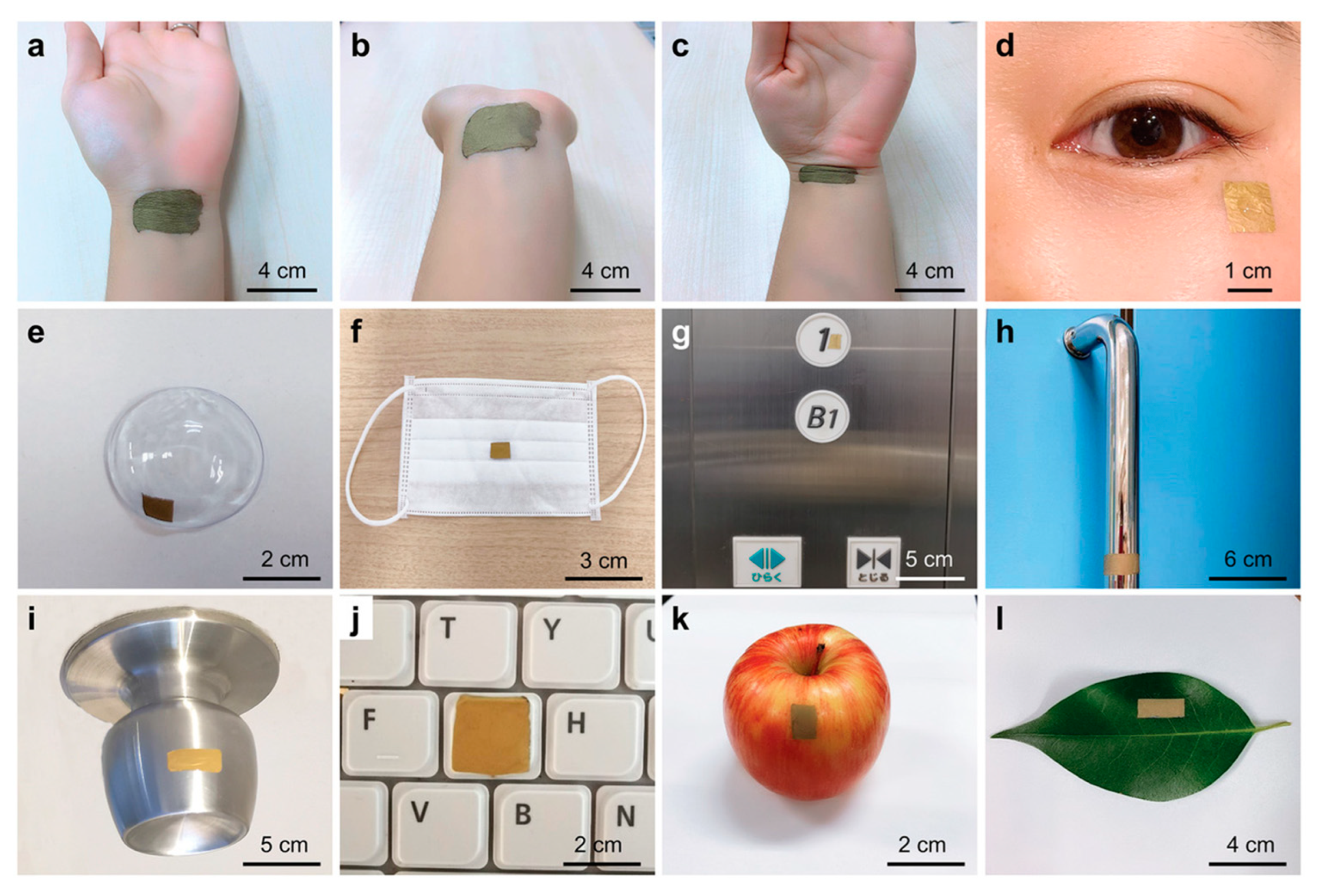

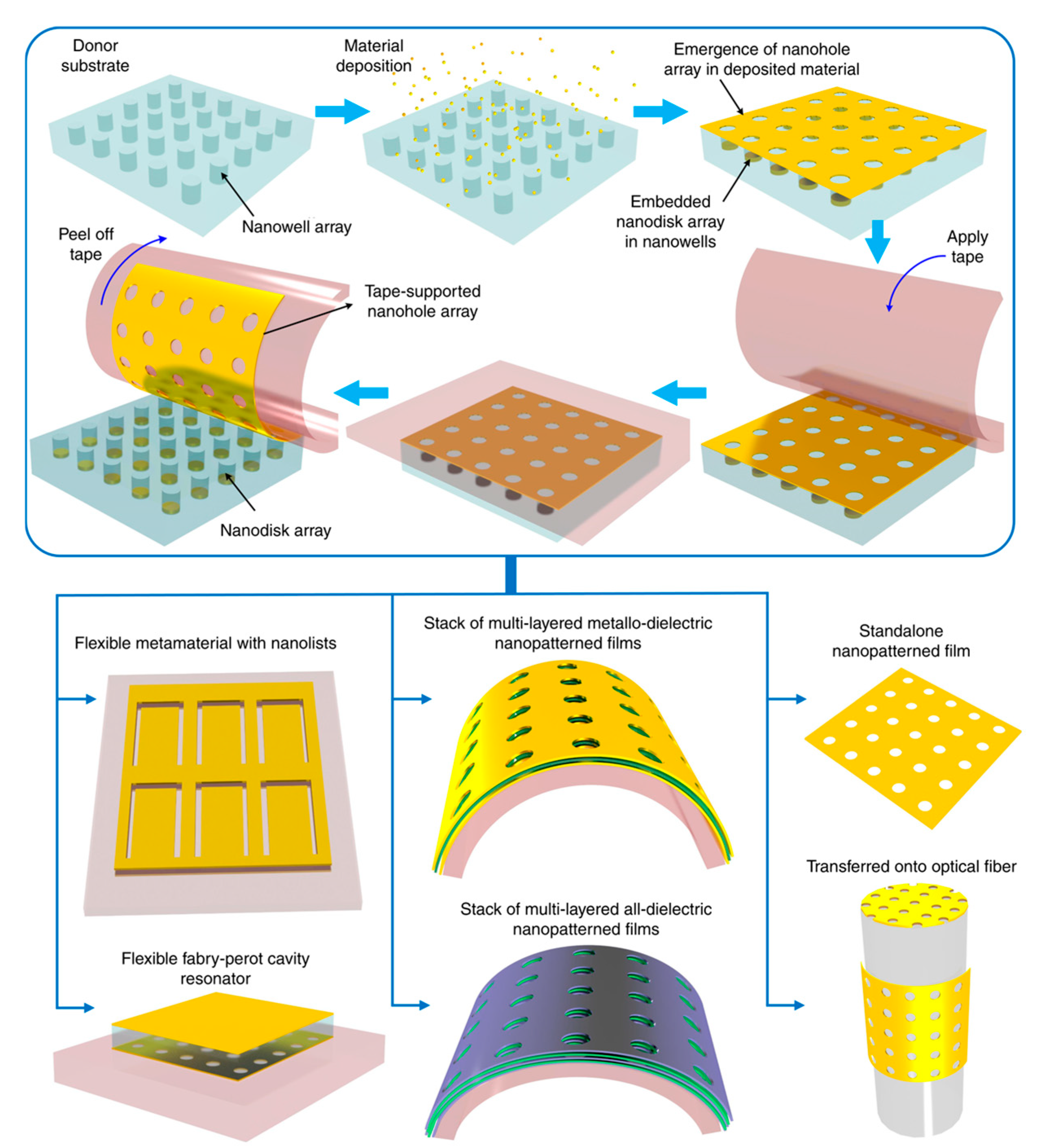


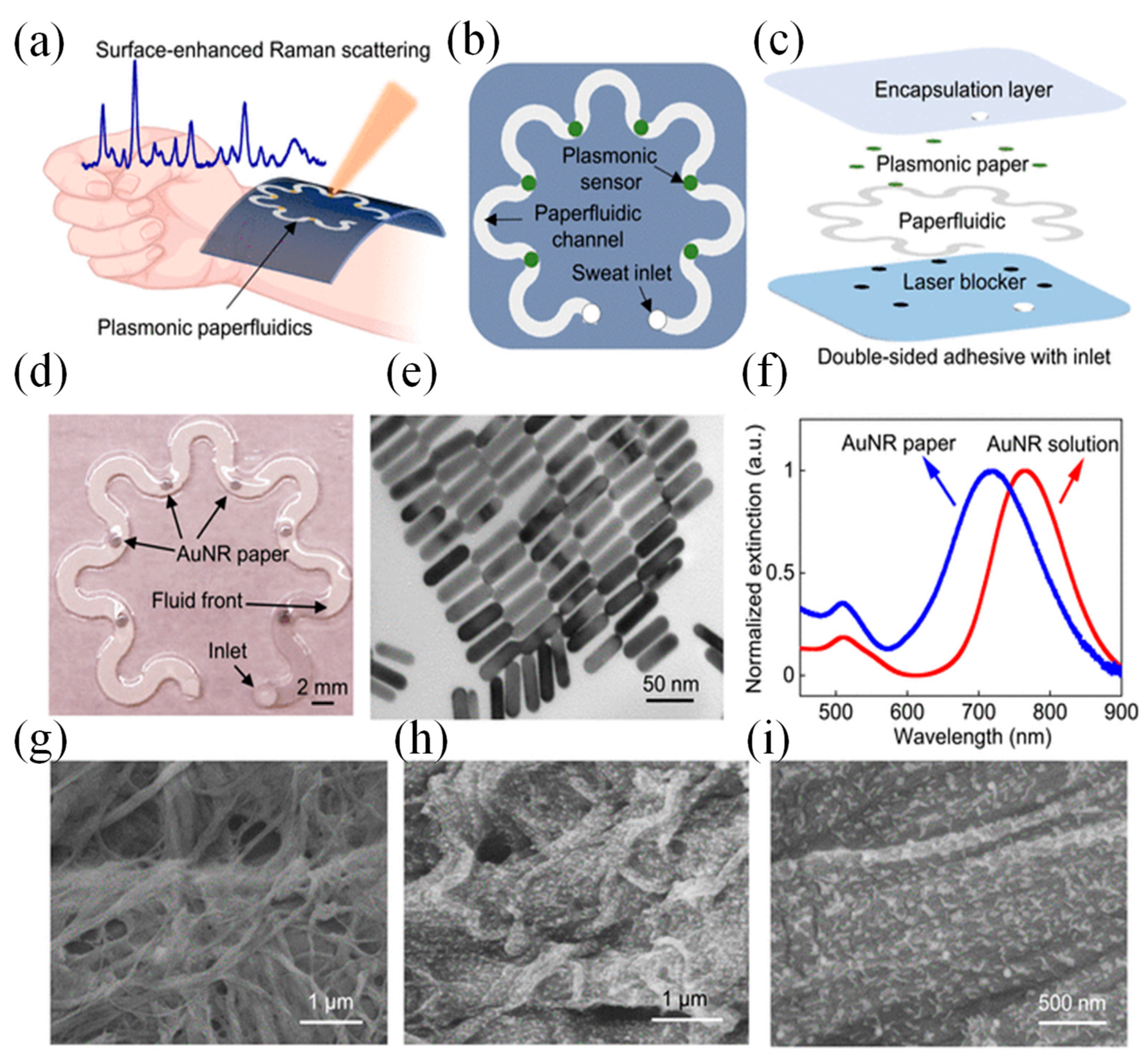
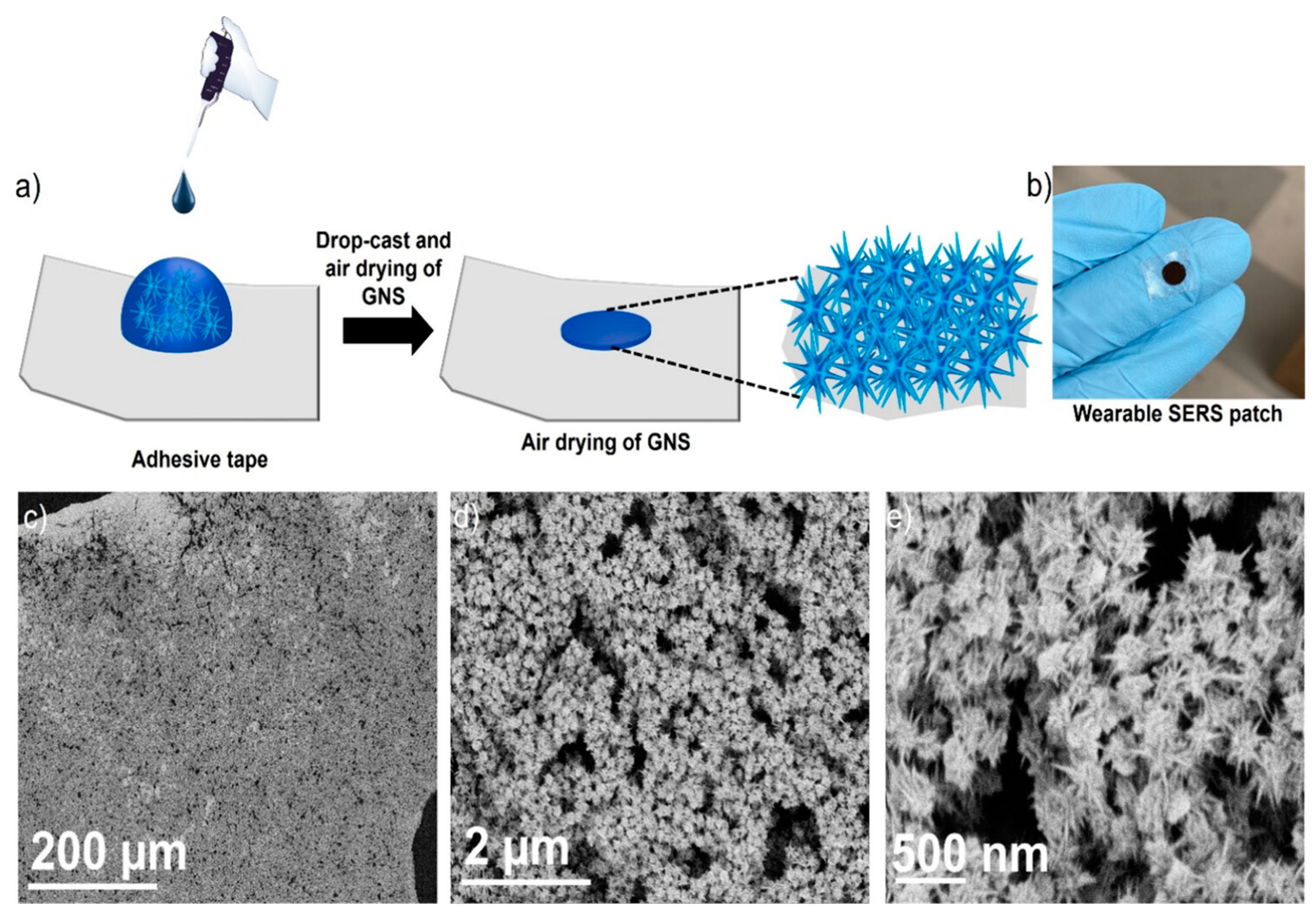
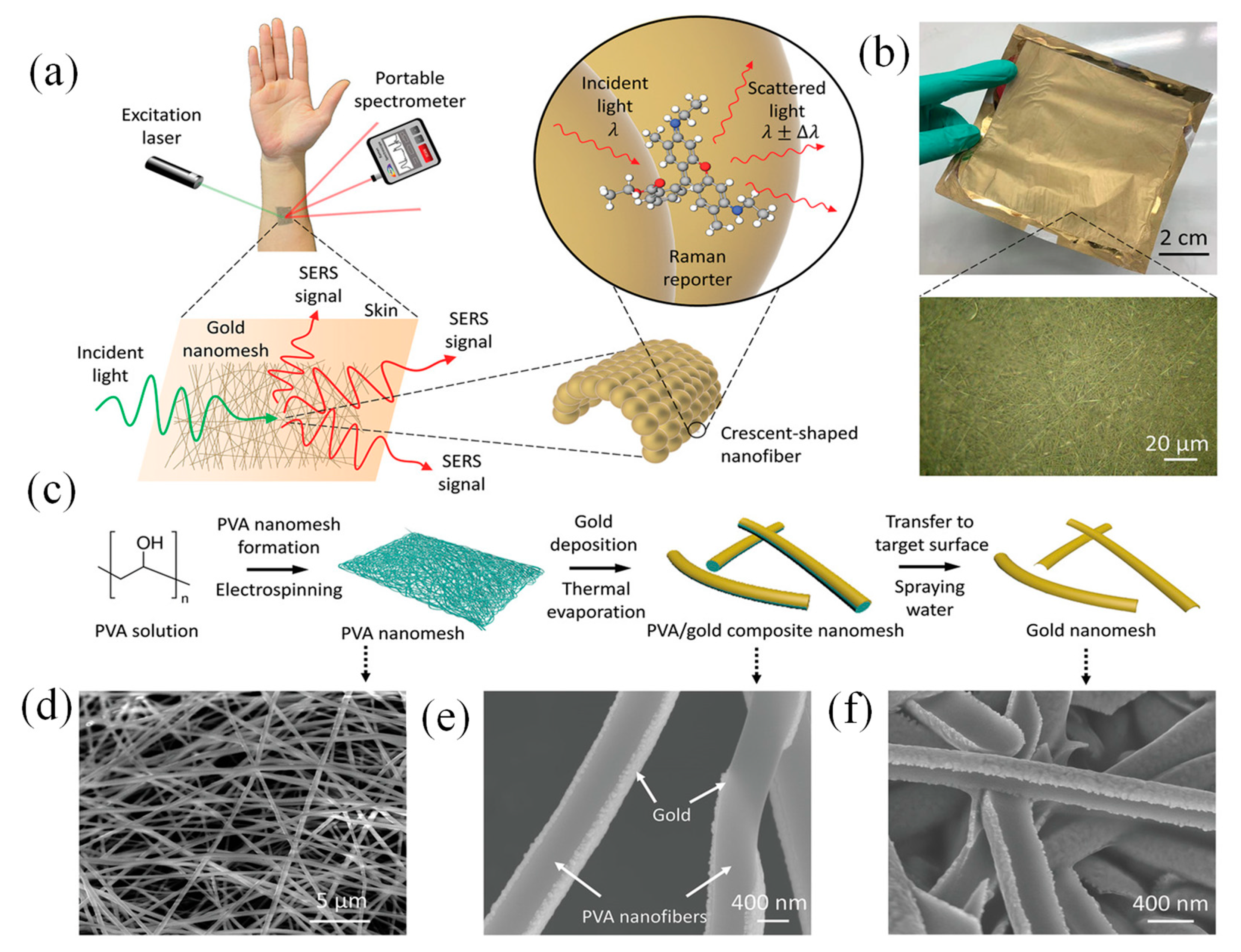
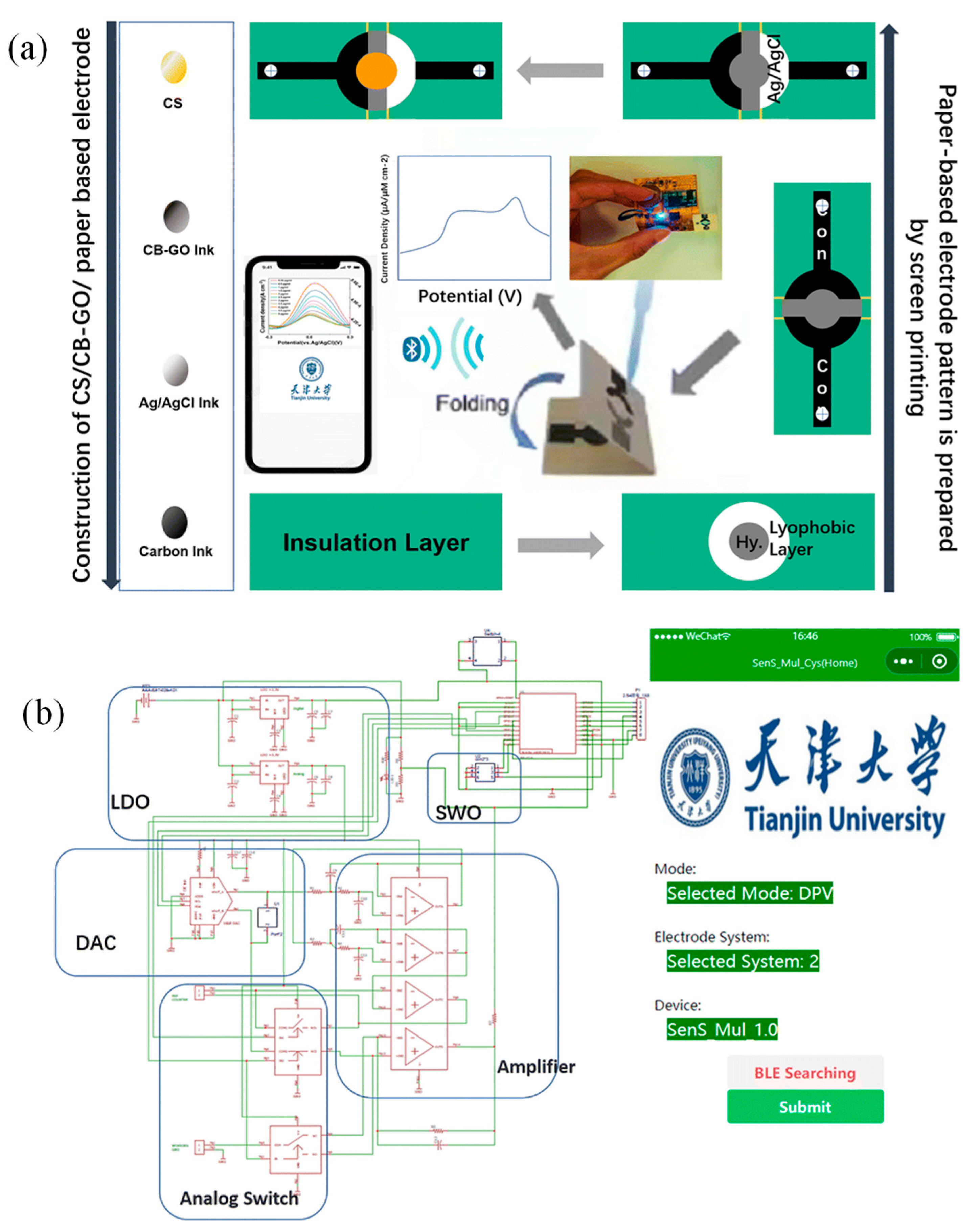
Disclaimer/Publisher’s Note: The statements, opinions and data contained in all publications are solely those of the individual author(s) and contributor(s) and not of MDPI and/or the editor(s). MDPI and/or the editor(s) disclaim responsibility for any injury to people or property resulting from any ideas, methods, instructions or products referred to in the content. |
© 2025 by the authors. Licensee MDPI, Basel, Switzerland. This article is an open access article distributed under the terms and conditions of the Creative Commons Attribution (CC BY) license (https://creativecommons.org/licenses/by/4.0/).
Share and Cite
Khonina, S.N.; Kazanskiy, N.L. Trends and Advances in Wearable Plasmonic Sensors Utilizing Surface-Enhanced Raman Spectroscopy (SERS): A Comprehensive Review. Sensors 2025, 25, 1367. https://doi.org/10.3390/s25051367
Khonina SN, Kazanskiy NL. Trends and Advances in Wearable Plasmonic Sensors Utilizing Surface-Enhanced Raman Spectroscopy (SERS): A Comprehensive Review. Sensors. 2025; 25(5):1367. https://doi.org/10.3390/s25051367
Chicago/Turabian StyleKhonina, Svetlana N., and Nikolay L. Kazanskiy. 2025. "Trends and Advances in Wearable Plasmonic Sensors Utilizing Surface-Enhanced Raman Spectroscopy (SERS): A Comprehensive Review" Sensors 25, no. 5: 1367. https://doi.org/10.3390/s25051367
APA StyleKhonina, S. N., & Kazanskiy, N. L. (2025). Trends and Advances in Wearable Plasmonic Sensors Utilizing Surface-Enhanced Raman Spectroscopy (SERS): A Comprehensive Review. Sensors, 25(5), 1367. https://doi.org/10.3390/s25051367






